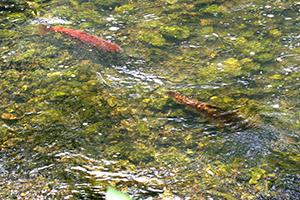Kenai Peninsula Salmon
Salmon are anadromous, which means they divide their lives between freshwater and the ocean. This annual return of salmon to freshwater is economically and culturally important to Alaska.

Salmon are anadromous, which means they divide their lives between freshwater and the ocean. This annual return of salmon to freshwater is economically and culturally important to Alaska, particularly to the state’s Kenai Peninsula, where 20 riparian corridors provide 900 miles of important habitat to salmon. Five Pacific salmon species spawn within the 6 million-acre Kenai Peninsula: sockeye salmon (Oncorhynchus nerka), pink salmon (O. gorbuscha), chum salmon (O. keta), chinook salmon (O. tshawytscha), and coho salmon (O. kisutch). Alaska’s $230 million commercial salmon fisheries depend on the spawning habitat, and many Alaskans rely on subsistence-caught salmon for food and cultural purposes. Sport fishing brings thousands of tourists to the area each summer, pouring needed recreational dollars into the Kenai Peninsula’s economy.
One of the largest threats to salmon is the loss and degradation of habitat, especially in spawning grounds, as they prefer shallow areas with moderate to fast water current and clean gravel with little silt or mud. Nutrient and sediment pollution from different sources and development both pose threats to salmon habitat. The NRCS is working with agricultural producers on the Kenai Peninsula to make conservation improvements on private lands in an effort to improve the health of riparian corridors and reduce the runoff of any nutrients and sediment from agricultural lands. This will help reverse the decline of salmon.

These landowners can voluntarily participate in the NRCS Environmental Quality Incentives Program (EQIP) to implement habitat improvement practices such as fish passage, stream bank restoration and erosion control. The EQIP program offers both technical and financial assistance.
NRCS offers technical and financial assistance to help landowners voluntarily conserve salmon habitat on private lands. This assistance helps producers plan and implement a variety of conservation activities or practices that benefit salmon as well as other fish species and wildlife. Common conservation practices include fish passage, stream bank restoration, stream crossings, erosion control, tree planting, and management of invasive plants.
Technical assistance is free to producers. The agency’s staff of experts and conservation partners work side-by-side with producers to develop a conservation plan. Each plan focuses on the restoration of salmon habitat and is tailored to the landowner’s property. These plans provide a roadmap for how to use a system of conservation practices to meet natural resource and production goals.
Financial assistance helps producers pay for the adoption of a system of conservation practices that improve and enhance salmon habitat and riparian areas. This assistance helps landowners improve salmon habitat.
The salmon project is part of the Working Lands for Wildlife (WLFW) partnership, a collaborative approach to conserve habitat on working lands. WLFW provides technical and financial assistance through EQIP, which is funded through the Farm Bill, the largest funding source for wildlife habitat conservation on private lands. NRCS also provides technical and financial assistance for other conservation practices such as high tunnels, irrigation systems, pasture planting and forest establishment, which play a critical role in improving water quality and riparian health.
This WLFW project aligns with “Kenai Mountains to Sea,” a 2016 conservation strategy developed by the Kachemak Heritage Land Trust, U.S. Fish and Wildlife Service, Audubon, Kenai Watershed Forum, Pacific Birds Habitat Joint Venture and Cook Inletkeeper. The strategy identified 20 riparian corridors that support anadromous habitat on the peninsula, and NRCS is targeting its conservation efforts in those corridors. The report identified 29 existing barriers to fish passage that NRCS is working with landowners to address.
Habitat restored for Pacific salmon species benefits other species including migratory birds, brown and black bears; moose and a wide variety of other vertebrates and invertebrates. Other anadromous fish such as steelhead, eulachon and lamprey also benefit.

